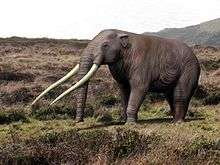Anancus
Anancus is an extinct genus of anancid proboscidean endemic to Africa, Europe, and Asia, that lived during the Turolian age of the late Miocene until the genus' extinction during the early Pleistocene, roughly from 7—1.5 million years ago.
| Anancus | |
|---|---|
| A. arvernensis skeleton | |
| Scientific classification | |
| Kingdom: | |
| Phylum: | |
| Class: | |
| Order: | |
| Family: | |
| Genus: | †Anancus Aymard, 1855 |
| Species | |
| |
Taxonomy

The type genus of the family, Anancus, was named by Auguste Aymard in 1855. It was traditionally allocated to Gomphotheriidae, but was later assigned to the family Elephantidae by McKenna and Bell (1997), Lambert and Shoshani (1998), Kalb and Froelich (1995), and Shoshani and Tassy (2005). Hautier et al. (2009) assigned the genus to the subfamily Anancinae within Gomphotheriidae.[1] Recently Anancus along with other tetralophodont gomphotheres have been removed from Gomphotheridae into their own family, Anancidae.[2][3][4]
Description

Anancus stood around 3 metres (9.8 ft) tall, with a weight up to 5 tons, and closely resembled a modern elephant.[5] Aside from its somewhat shorter legs, Anancus was also different from modern elephants in that its tusks were much longer, up to 4 metres (13 ft) in length.[6] The tusks were possibly defense weapons, not unlike elephants of today.[7][8] The molars were not composed of lamellae like those of true elephants, but had cusps, like tapir and pig molars; Anancus appears to have lived in forests, eating from trees and shrubs and digging out tubers and roots in the forest floor, and it died out when these forests gave way to grasslands.[6]
Gallery
- The jaw of Anancus, an extinct elephant
- Jaw of Anancus arvernensis from Quaternary of Italy
- Molar of Anancus arvernensis
References
- Hautier et al., 2009. New material of Anancus kenyensis (Proboscidea, Mammalia) from Toros-Menalla (Late Miocene, Chad): Contribution to the systematics of African anancines. Journal of African Earth Sciences 53:171-176.
- J. Shoshani and P. Tassy. 2005. Advances in proboscidean taxonomy & classification, anatomy & physiology, and ecology & behavior. Quaternary International 126-128:5-20
- J. Shoshani and P. Tassy. 1996. Summary, conclusions, and a glimpse into the future. in J. Shoshani and P. Tassy, eds., The Proboscidea: Evolution and Palaeoecology of Elephants and Their Relatives 335-348
- Mothé D, Ferretti MP, Avilla LS (2016) "The Dance of Tusks: Rediscovery of Lower Incisors in the Pan-American Proboscidean Cuvieronius hyodon Revises Incisor Evolution in Elephantimorpha". PLoS ONE 11(1): e0147009. doi:10.1371/journal.pone.0147009
- http://donsmaps.com/mastodon.html Mastodons and related early elephants
- Palmer, D., ed. (1999). The Marshall Illustrated Encyclopedia of Dinosaurs and Prehistoric Animals. London: Marshall Editions. p. 241. ISBN 1-84028-152-9.
- The Free Dictionary: Tusks
- Upali.ch Elephants in Zoo and Circus, Teeth, second dentition, tusks.
- Benes, Josef (1979). Prehistoric Animals and Plants. Prague: Artua. p. 263.